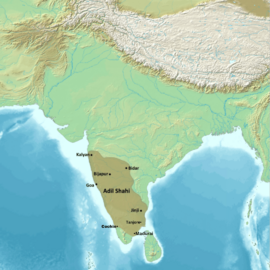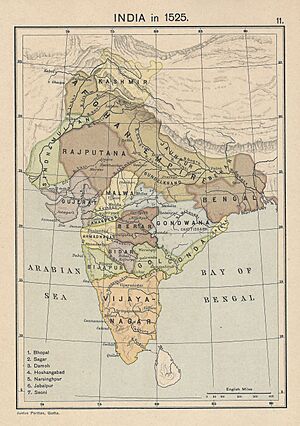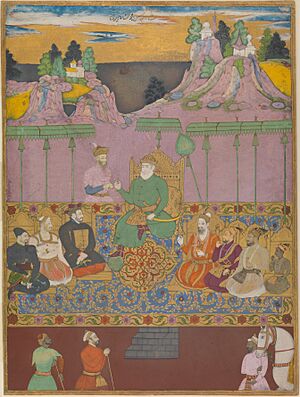Sultanate of Bijapur facts for kids
Quick facts for kids
Sultanate of Bijapur
|
|||||||||||||
|---|---|---|---|---|---|---|---|---|---|---|---|---|---|
| 1490–1686 | |||||||||||||

Map of the Adil Shahi dynasty of the Bijapur Sultanate at its greatest extent
|
|||||||||||||
| Capital | Bijapur | ||||||||||||
| Official languages | Persian | ||||||||||||
| Common languages | |||||||||||||
| Religion |
|
||||||||||||
| Government | Monarchy | ||||||||||||
| Sultan | |||||||||||||
|
• 1490–1510
|
Yusuf Adil Shah (first) | ||||||||||||
|
• 1672–1686
|
Sikandar Adil Shah (last) | ||||||||||||
| Historical era | Early modern | ||||||||||||
|
• Established
|
1490 | ||||||||||||
|
• Disestablished
|
1686 | ||||||||||||
|
|||||||||||||
| Today part of | India | ||||||||||||
The Sultanate of Bijapur was an important kingdom in western Deccan and South India. It was ruled by the Adil Shahi family, also known as the Adilshahi dynasty. Before it became independent in 1490, Bijapur was a province of the Bahmani Sultanate.
The Bijapur Sultanate was one of five new states that formed after the Bahmani Sultanate became weak. These states are known as the Deccan Sultanates. At its strongest, the Sultanate of Bijapur was one of the most powerful states in South Asia. Only the Mughal Empire was stronger. The Mughals eventually conquered Bijapur on September 12, 1686.
The founder of the Sultanate was Yusuf Adil Shah. He was first a governor for the Bahmani rulers. He later took control of Bijapur and made it an independent state in 1490. It became fully independent in 1518 when the Bahmani Sultanate collapsed.
The borders of the Bijapur Sultanate changed a lot over time. Its northern border stayed mostly the same, covering parts of modern-day Maharashtra and Karnataka. The Sultanate grew southward after defeating the Vijayanagara Empire in the Battle of Talikota in 1565. Later, during the rule of Mohammed Adil Shah (1627–1656), Bijapur's power reached as far south as Tanjore. For most of its history, Bijapur was bordered by Goa (controlled by the Portuguese) to the west, the Sultanate of Golconda to the east, and the Ahmednagar Sultanate to the north.
The city of Bijapur was the capital of the Sultanate throughout its existence. Early rulers like Ibrahim Adil Shah I and Ali Adil Shah I (1558–1579) rebuilt Bijapur. They added a strong citadel, city walls, and a large mosque. Later rulers, including Ibrahim Adil Shah II (1579–1627), Mohammed Adil Shah (1627–1656), and Ali Adil Shah II (1656–1672), built more palaces, mosques, and tombs. These buildings are considered beautiful examples of Deccani architecture and Indo-Islamic architecture.
The Bijapur Sultanate often fought with its neighbors. In 1565, the Deccan Sultanates joined forces to defeat Vijayanagara at the Battle of Talikota. Bijapur also expanded by conquering the Bidar Sultanate in 1619. Later, the Sultanate was weakened by the revolt of Shivaji. He created an independent Maratha Kingdom, which became the Maratha Confederacy. The biggest threat to Bijapur was the expanding Mughal Empire. The Mughals slowly took control, forcing Bijapur to accept their authority by 1636. The Mughals demanded a lot of wealth, which weakened Bijapur until its final conquest in 1686.
Contents
History of Bijapur

The Early Years (1490-1534)
The founder of the Bijapur dynasty was Yusuf Adil Shah. Some historians believe he was a Georgian slave bought from Iran. Others say he was of Persian or Turkmen origin. Yusuf was brave and quickly gained favor with the Bahmani Sultan. He was made Governor of Bijapur. In 1490, Yusuf took advantage of the Bahmani Sultanate's decline and declared Bijapur an independent sultanate.
In 1504, Yusuf conquered the province of Gulbarga. After this, he made Shia Islam the official religion of his lands. Yusuf died in 1510 during a fight with Krishnadevaraya of the Vijayanagara Empire. His son, Ismail Adil Shah, was still young.
Ismail's regent, Kamal Khan, tried to take power but failed. So, Ismail became the full ruler. In 1510, the Portuguese, led by Afonso de Albuquerque, captured the important port of Goa. Ismail briefly retook it, but the Portuguese captured it again later that year. In 1520, Krishnadevaraya attacked the Bijapuri fort of Raichur. Ismail was defeated in the Battle of Raichur, and Raichur was captured. Ismail later recaptured Raichur and Mudgal in 1530.
Changes and Conflicts (1534-1579)
Mallu Adil Shah became sultan in 1534, but his rule was very short. He was not a strong leader, and Vijayanagara invaded and took back the Raichur Doab region. Mallu was soon removed from power.
Ibrahim Adil Shah I, Ismail's son, became sultan in 1534. He changed the state religion back to Sunni Islam. He also made big changes to the court, reducing the use of Persian in some government tasks. Ibrahim invaded the Vijayanagara Empire, but he did not gain new land. He only took valuable goods. His kingdom was invaded four times by the Ahmednagar Sultanate, Bijapur's biggest enemy.
Ali Adil Shah I became sultan in 1558. He brought back Shia Islam as the state religion. He allied with Vijayanagara and Golconda to fight Ahmednagar. Later, Ali became worried about Vijayanagara's growing power. So, he joined forces with the Sultans of Golconda, Ahmednagar, and Bidar. Together, they defeated the Vijayanagara Empire in the important Battle of Talikota in 1565. The city of Vijayanagara was looted and destroyed. Bijapur regained control of Mudgal and the Raichur Doab. Ali also fought the Portuguese but was defeated in 1571. He then conquered more land from Vijayanagara in the south.
Later Rulers and Decline (1579-1686)
Since Ali I had no son, his nephew Ibrahim Adil Shah II became sultan in 1579 when he was only nine years old. Ali I's queen, Chand Bibi, helped him rule until he was old enough. Ibrahim II founded the city of Nauraspur in 1599, planning it as a center for learning and art. However, it was never fully finished. In 1619, Bijapur conquered the neighboring Bidar Sultanate. Ibrahim II also built many beautiful buildings near Bijapur, known as the Ibrahim Rauza.
Muhammad Adil Shah became sultan in 1627. During his rule, the Sultanate of Bijapur reached its largest size and greatest wealth. He is famous for building his own tomb in Bijapur, called the Gol Gumbaz. The Mughal Empire invaded Bijapur for the first time in 1631, led by Shah Jahan. They besieged Bijapur but were unsuccessful. However, Bijapur was forced to recognize Mughal authority in 1636 and pay tribute. The Sultanate began to decline due to problems with nobles and the revolt of Shivaji, a Maratha governor. Muhammad died in 1656 after a long illness.
Ali Adil Shah II inherited a kingdom facing many problems. Mughal forces invaded in 1657, led by Aurangzeb. They captured Bidar and other forts. The Marathas also continued their raids and rebellions. A Bijapuri general, Afzal Khan, was sent to defeat Shivaji in 1659 but was killed. Despite these challenges, Ali continued to expand Bijapur's territory in the south, capturing Tanjore from 1659–63.
Sikandar Adil Shah was the last Adil Shahi sultan, ruling for fourteen difficult years. He was only four years old when he became sultan, and there were many civil wars and internal conflicts over who should rule for him. In 1674, Shivaji formally created an independent Maratha Kingdom. He took back almost all of Bijapur's southern conquests, including Tanjore. On September 12, 1686, the Mughal armies under Aurangzeb finally conquered the city of Bijapur after a long siege. This marked the end of the Sultanate of Bijapur.
Culture
Architecture
The buildings of the Bijapur Sultanate are part of Deccani architecture. This style was influenced by Middle Eastern architecture and is a type of Indo-Islamic architecture. Adil Shahi buildings are known for their high quality and unique local style. They often feature large domes, special tombs called dargahs, complex towers, and designs with geometric shapes or Arabic writing.
Yusuf Adil Shah, the first sultan, started by adding to two Sufi tombs in Gulbarga. The first building to fully show the Adil Shahi style was a mosque built during the rule of Ibrahim Adil Shah I. The main Jami Masjid of Bijapur was built under Ali Adil Shah I in 1576.
Under Ibrahim Adil Shah II, the architecture became more detailed. His most famous work is the Ibrahim Rauza, finished in 1626. It includes a mosque and a mausoleum for his family. Mohammed Adil Shah built the Gol Gumbaz, his own tomb. It has a huge dome, which was one of the largest in the Islamic world when it was finished around 1656. The last major Adil Shahi building project was the unfinished tomb of Ali Adil Shah II, called the Bara Kaman. Construction stopped when he died in 1672.
Painting and Literature
The Adil Shahis were interested in miniature painting, especially through the Bijapur school of Deccani painting. This type of painting became popular under Ali Adil Shah I and grew even more under Ibrahim Adil Shah II. Bijapur paintings were influenced by Persian miniature painting. They often showed beautiful scenes and dreams, rather than battles or real-life events.
The Adil Shahi sultans also supported writing in the Deccani language. Bijapur became an important center for its early development. Ibrahim II was a skilled writer of Deccani Urdu literature. He wrote Kitab-e-Navras, a book of musical poetry. He also supported many poets, including Muhammad Zuhuri. Another poet, Firishta, wrote an important history of the medieval Deccan called Tarikh-i Firishta at Ibrahim's suggestion. This book is still used by historians today.
List of Rulers
Nine sultans ruled the Sultanate of Bijapur from 1490 to 1686.
| Adil Shahi dynasty | |||||||||||||||||||||||||||||||||||||||||||||||||||||||||||||||||||||||||||||||||||||||||||||||||||||||||||||||||||||||||||||||||||||||||||||||||||||||||||||||||||||||||||||||||||||||||||||||||||||||||||||||||||||||||||||||||||||||||||||||||||||||||||||||
|---|---|---|---|---|---|---|---|---|---|---|---|---|---|---|---|---|---|---|---|---|---|---|---|---|---|---|---|---|---|---|---|---|---|---|---|---|---|---|---|---|---|---|---|---|---|---|---|---|---|---|---|---|---|---|---|---|---|---|---|---|---|---|---|---|---|---|---|---|---|---|---|---|---|---|---|---|---|---|---|---|---|---|---|---|---|---|---|---|---|---|---|---|---|---|---|---|---|---|---|---|---|---|---|---|---|---|---|---|---|---|---|---|---|---|---|---|---|---|---|---|---|---|---|---|---|---|---|---|---|---|---|---|---|---|---|---|---|---|---|---|---|---|---|---|---|---|---|---|---|---|---|---|---|---|---|---|---|---|---|---|---|---|---|---|---|---|---|---|---|---|---|---|---|---|---|---|---|---|---|---|---|---|---|---|---|---|---|---|---|---|---|---|---|---|---|---|---|---|---|---|---|---|---|---|---|---|---|---|---|---|---|---|---|---|---|---|---|---|---|---|---|---|---|---|---|---|---|---|---|---|---|---|---|---|---|---|---|---|---|---|---|---|---|---|---|---|---|---|---|---|---|---|---|---|---|
|
|||||||||||||||||||||||||||||||||||||||||||||||||||||||||||||||||||||||||||||||||||||||||||||||||||||||||||||||||||||||||||||||||||||||||||||||||||||||||||||||||||||||||||||||||||||||||||||||||||||||||||||||||||||||||||||||||||||||||||||||||||||||||||||||
| Title | Name | Years Ruled | |
|---|---|---|---|
| Became independent from the Bahmani Sultanate (1490) | |||
| Amir أمیر |
Yusuf Adil Shah یوسف عادل شاہ |
1490–1511 | |
| Adil Khani عادل خانی |
Ismail Adil Shah اسماعیل عادل شاہ |
1511–1534 | |
| Adil Khani عادل خانی |
Mallu Adil Shah ملو عادل شاہ |
1534 | |
| Adil Khani عادل خانی |
Ibrahim Adil Shah I ابراہیم عادل شاہ اول |
1534–1558 | |
| Adil Khani عادل خانی |
Ali Adil Shah I علی عادل شاہ اول |
1558–1580 | |
| Adil Khani عادل خانی |
Ibrahim Adil Shah II ابراہیم عادل شاہ دوئم |
1580–1627 | |
| Adil Khani عادل خانی |
Mohammed Adil Shah محمد عادل شاہ |
1627–1657 | |
| Adil Khani عادل خانی |
Ali Adil Shah II علی عادل شاہ دوئم |
1657–1672 | |
| Adil Khani عادل خانی |
Sikandar Adil Shah سکندر عادل شاہ |
1672–1686 | |
| Conquered by Aurangzeb of the Mughal Empire in 1686. | |||
See also
- Islam in South Asia
- Adil Shahi–Portuguese conflicts




